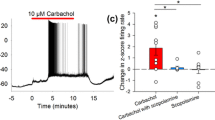Summary
In the chick embryo a cholinesterase activity appears in various organ anlagen which has been correlated with morphogenetic movements (Drews 1975). The cholinesterase activity is present in the mesenchyme of the limb bud during aggregation of the central chondrogenic core. In the present study binding of tritium labelled quinuclidinyl benzilate ((3H)QNB), a muscarinic antagonist, to homogenates of chick limb buds was investigated by a filtration assay. In the homogenate of limb buds at Stage 24 specific binding of (3H)QNB was demonstrated. Determination of binding constants and inhibition of binding by agonists and antagonists was studied at Stage 25/26. Specific binding was defined by the difference in binding in the absence and presence of atropine (1 μM). Specific binding of (3H)QNB reflected a muscarinic receptor. The Kd in two experiments was 0.11 nM and 0.16 nM, the binding capacity was 15.7 fmol (3H)QNB/mg protein and 12.0 fmol (3H)QNB/mg protein, respectively. Data on displacement of specific bound (3H)QNB by various nicotinic and muscarinic ligands confirmed the muscarinic nature of the receptor. Muscarinic ligands inhibited the (3H) QNB binding, whereas nicotinic ligands caused no inhibition at pharmacological concentrations. I conclude that a specific muscarinic acetylcholine receptor is part of the cholinergic system whose presence is indicated by cholinesterase activity in the chondrogenic core of the limb bud during morphogenesis.
Similar content being viewed by others
References
Albanus L (1970) Central and peripheral effects of anticholinergic compounds. Acta Pharmacol Toxicol 28:305–326
Birdsall NJM, Hulme EC (1976) Biochemical studies on muscarinic acetylcholine receptors. J Neurochem 27:7–16
Birdsall NJM, Burgen ASV, Hulme EC (1978) The binding of agonists to brain muscarinic receptors. Mol Pharmacol 14:723–736
Cavey D, Vincent JP, Làzdunski M (1977) The muscarinic receptors of heart cell membranes. FEBS Lett 84:110–114
Chang KJ, Jacobs S, Cuatrecasas P (1975) Quantitative aspects of hormone — receptor interactions of high affinity. Effect of receptor concentration and measurement of dissociation constants of labeled and unlabeled hormones. Biochim Biophys Acta 406:294–303
Cuatrecasas P, Hollenberg MD (1976) Membrane receptors and hormone action. Adv Protein Chem 30:251–451
Drews U (1975) Cholinesterase in embryonic development. Prog Histochem Cytochem Vol. 7/3. Gustav Fischer, Stuttgart
Drews U, Drews U (1972) Cholinesterase in der Extremitättenentwicklung des Hühnchens: Die Phasen der Cholinesterase-Aktivität in der jungen Knospe und bei der Abgrenzung von Knorpel-und Muskelanlagen. Wilhelm Roux' Arch 169:70–86
Drews U, Kussäther E, Usadel KH (1967) Histochemischer Nachweis der Cholinesterase in der Frühentwicklung der Hühnerkeimscheibe. Histochemie 8:65–89
Fambrough D, Rash JE (1971) Development of acetylcholine sensitivity during myogenesis. Dev Biol 26:55–68
Fields JZ, Roeske WR, Morkin E, Yamamura HI (1978) Cardiac muscarinic cholinergic receptors. Biochemical identification and characterization. J Biol Chem 253:3251–3258
Fluck RA (1978) Acetylcholine and acetylcholinesterase activity in early embryos of the medakaOryzias latipes, a teleost. Dev Growth Differ 20:17–25
Galper JB, Klein W, Catterall WA (1977) Muscarinic acetylcholine receptors in developing chick heart. J Biol Chem 252:8692–8699
Gustafson T, Toneby M (1970) On the role of serotonin and acetylcholine in sea urchin embryogenesis. Exp Cell Res 62:102–117
Hamburger V, Hamilton HL (1951) A series of normal stages in the development of the chick embryo. J Morphol 88:49–92
Heidmann T, Changeux J-P (1978) Structural and functional properties of the acetylcholine receptor protein in its purified and membrane — bound states. Annu Rev Biochem 47:317–357
Heilbronn E, Bartfai T (1978) Muscarinic acetylcholine receptor. Prog Neurobiol 11:171–188
Hill AV (1909) The mode of action of nicotine and curarine determined by the form of the concentration curve and the method of temperature coefficients. J Physiol (Lond) 39:361–373
Hulme EC, Birdsall NJM, Burgen ASV, Mehta P (1978) The binding of antagonists to brain muscarinic receptors. Mol Pharmacol 14:737–750
Janssen PAJ, Niemegeers CJE, Schellekens KHL, Demoen P, Lenaerts FM, Van Nueten JM, Van Wijngaarden I, Brugmans J (1971) Benzetimide and its optical isomers. Arzneim-Forsch 21:1365–1373
Kocher-Becker U, Drews U, Drews U (1975) Histochemischer Nachweis der Cholinesterase-Aktivität während der Gastrulation des Seeigels. Wilhelm Roux' Arch 178:157–165
Lowry OH, Rosebrough NJ, Farr AL, Randall RJ (1951) Protein measurement with the Folin phenol reagent. J Biol Chem 193:265–275
Meyerhöffer A (1972) Absolute configuration of 3-quinuclidinyl benzilate and the behavioral effect in the dog of the optical isomers. J Med Chem 15:994–995
Ozaki H (1976) Molecular properties and differentiation of acetylcholinesterase in sea urchin embryos. Dev Growth Differ 18:245–257
Penner PL (1977) Acetylcholinesterase and cell movement in the epiblast of the primitive streak chick embryo. Doctoral thesis. New York University, New York
Sastre A, Gray DB, Lane M-A (1977) Muscarinic cholinergic binding sites in the developing avian heart. Dev Biol 55:201–205
Scatchard G (1949) The attractions of proteins for small molecules and ions. Ann NY Sci 51:660–672
Schröder CH (1980), Characterization of embryonic cholinesterase in chick limb bud by colorimetry and disk electrophoresis. Histochemistry 69:243–253
Shainberg A, Brik H (1978) The appearance of acetylcholine receptors triggered by fusion of myoblasts in vitro. FEBS Lett 88:327–331
Sugiyama H, Daniels MP, Nirenberg M (1977) Muscarinic acetylcholine receptor of the developing retina. Proc Natl Acad Sci USA 74:5524–5528
Wastek GJ, Yamamura HI (1978) Biochemical characterization of the muscarinic cholinergic receptor in human brain: Alterations in Huntington's disease. Mol Pharmacol 14:768–780
Yamamura HI, Snyder SH (1974a) Muscarinic cholinergic binding in rat brain. Proc Natl Acad Sci USA 71:1725–1729
Yamamura HI, Snyder SH (1974b) Muscarinic cholinergic binding in the longitudinal muscle of the guinea pig ileum with (3H) quinuclidinyl benzilate. Mol Pharmacol 10:861–867
Author information
Authors and Affiliations
Rights and permissions
About this article
Cite this article
Schmidt, H. Muscarinic acetylcholine receptor in chick limb bud during morphogenesis. Histochemistry 71, 89–98 (1981). https://doi.org/10.1007/BF00592573
Received:
Accepted:
Issue Date:
DOI: https://doi.org/10.1007/BF00592573




